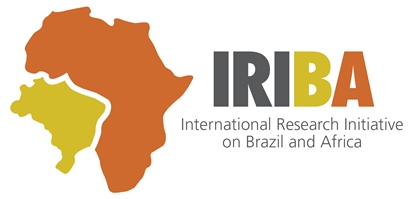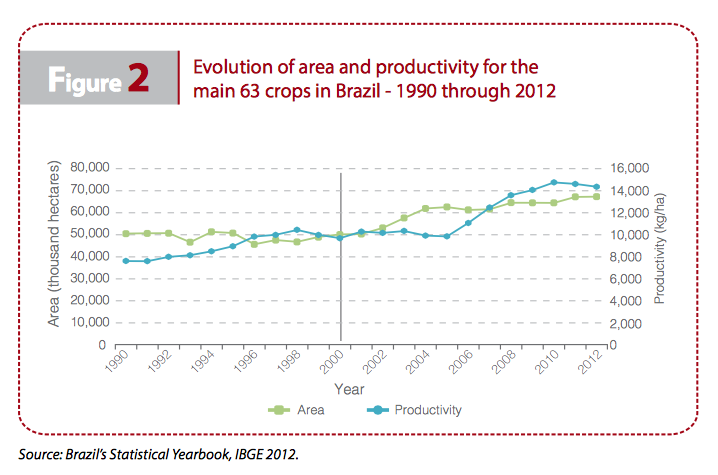This overview is based on IRIBA Working Paper 2: ‘What explains the intensification and diversification of Brazil’s agricultural production and exports from 1990 to 2012?’, by Carlos Bacha and Leandro Vinicios de Carvalho.
Key findings
Agro-based product exports increased from USD9.6 billion in 1991 to USD87.6 billion in 2011. Agro-processed products have been responsible for almost two-thirds of total exports. New econometric analysis undertaken demonstrates that:
- World GDP has the biggest impact on the increase of Brazil’s agricultural and agro-processed product exports. A 1 per cent increase in world GDP leads to an increase of 1.56 per cent in Brazil’s agricultural and agro-industrial exports; and
- The second biggest impact comes from the expansion of Brazil’s agricultural production. International price was not a significant factor behind the growth in Brazil’s agricultural and agro-processed product exports.
Agricultural policy in Brazil
Since the second half of the 1960s, despite changes in focus and endowments, the Federal Government has maintained traditional agricultural policies such as rural credit, minimum prices, insurance, research and extension. Overall, these policies have stimulated market-oriented production rather than subsistence agriculture. Since the 1960s, three broad periods of Brazilian agricultural policymaking can be identified:
1964–1985
During the military dictatorship, economic policy focussed on increasing the growth rate of gross domestic product (GDP), reducing inflation and generating a trade balance surplus. These targets aimed to modernise the labour market in rural areas and offered economic stimulus to market-oriented farmers, rather than the agrarian reform advocated by some groups in the late 1950s to early 1960s.
In 1965, the Federal Government created the National System of Rural Credit (SNCR), which became a crucial source of low-interest loans for farmers looking to purchase industrial inputs and machinery and was, therefore, a key step in increasing agricultural productivity.
1987–1999
As the new democratic administrations struggled to stabilise the Brazilian currency by reducing the public deficit, government endowments to earlier-established agricultural policies were drastically reduced, and, simultaneously, new programmes were created to involve the private sector in the agricultural financing process.
2000–2012
From 2000 onwards, left-wing parties strengthened their position both inside and outside the Federal Government, resulting in increased support to family farmers. At the end of 1999, the Ministry of Agrarian Development (MDA) was created to support family farming, while the Ministry of Agriculture, Livestock and Supply (MAPA) continued to focus on non-family farming. Since then, the MDA and the MAPA have shared the responsibility for supporting Brazilian agriculture, by using the same policies (rural credit, minimum prices, rural extension and subsidised insurance) but with programmes tailored to their respective sectors (family and non-family).
The success of Brazilian agriculture
Both agricultural and livestock production have increased enormously in Brazil since the 1990s, particularly since 2000. Looking at the 63 main crops (including sugar cane), agricultural production totalled 384 million tonnes in 1990, 485 million tonnes in 2000 and 966 million tonnes in 2012 (see Figure 1). The annual geometric rate of growth for crop quantity during the 1990s was 3.2 per cent, rising to 6.7 per cent between 2000 and 2012. This growth was achieved by increasing productivity, as shown in Figure 2.
Figure 1.
Meat production also saw a large increase (see Figure 3). Total meat production in 1990 was 5.17 million tonnes, rising to 10.33 million tonnes by 2000 and 22.35 million tonnes by 2012. The annual geometric rate of growth for meat production was 7.04 per cent during the 1990s and 6.39 per cent between 2000 and 2012.
The key drivers behind Brazil’s increasing agricultural production have been:
- Good availability of arable land, especially with the development of new agricultural frontiers in the Centre-West region in the 1970s to 1990s and in MATOPIBA1 since 2000;
- Modern technology generated by a network that encompasses the Brazilian Enterprise for Agricultural Research (EMBRAPA), public universities, state-funded agricultural research institutes and privately funded organisations;
- State-funded agricultural policies;
- The availability of international markets for Brazilian production and the role of large multinational agribusiness companies; and
- The presence of market-oriented farmers in the categories of both family and non-family farming.
- Brazil also has eco-climatic features conducive to raising cattle and cultivating crops. In some areas, it is possible to plant three crops in the same area during the same farming year without needing to leave the land fallow. For example, with good seeds and fertiliser, in the state of Paraná it is possible to plant and harvest soybean from September to March, beans from March to April and corn from late April to August, before restarting the same sequence in the next farming year.
Figure 3.
Export growth
Brazil is currently the world’s largest producer and exporter of coffee, sugar and orange juice, the second largest exporter of soybeans, the third largest for corn and the fourth largest for cotton. Brazil is also the largest exporter of beef and poultry, with the largest commercial cattle herd (United States Department of Agriculture 2015).
Figure 4 shows the evolution of Brazil’s exports and imports of agricultural and agro-processed goods from 1990 to 2011. Brazil’s exports of agricultural and agro-processed products rose from USD10.2 billion in 1990 to almost USD87.5 billion in 2011, representing an eight-fold increase in 22 years. A particularly large increase has taken place since 2000, as the US and European Union (EU) shares of the global agricultural and agro-processed product markets have declined.
From 2000 to 2011, Brazil’s exports of agricultural and agro-processed products to EU countries increased by almost 200 per cent, even though the share of overall Brazilian agricultural/agro-processed exports represented by these countries actually decreased from 50 per cent to 27 per cent (Ipea).
African, Asian and Middle Eastern countries, especially China, have increased their imports of agricultural and agro-processed products from Brazil. In 2000, countries from these regions purchased 27 per cent of Brazil’s agricultural and agro-processed exports; by 2011, this percentage had climbed to 53 per cent. China alone accounted for 18 per cent of Brazil’s exports of agricultural and agro-processed goods in 2011.
Figure 4.
The role of agribusiness
Large multinational agribusiness companies have backed medium- and large-sized farmers in Brazil, encouraging them to produce exportable agricultural products. During the 1970s and 1980s, these companies subsidised farmers planting grains in Cerrado biome areas using the so-called Contratos de Soja Verde (Green Soybeans Contracts)—a forward sale not established by law, under which agribusiness companies lent money and/or agricultural inputs to the farmers and later received reimbursements in the form of agricultural products (soybeans). In the 1990s, this type of contract became regulated as a Note of Agricultural Product (Cédula de Produto Rural) and has been widely used since then.
Large multinational agribusinesses have consistently bought a large share of Brazilian agricultural production and exports; foreign markets have been an important destination for a sizeable proportion of Brazil’s agricultural production.
The role of agricultural research
Agricultural research has played a vital role in the growth of Brazilian agriculture. The development of new seeds and production techniques was a pre-requisite to enable farmers to bring the Cerrado and other areas into production.
Some commentators tend to assume that the spread of agriculture throughout the Cerrado biome is entirely due to EMBRAPA research (e.g. The Economist 2010: 3). However, while EMBRAPA performs an important role coordinating a large range of crop and livestock research, it is only one among a huge network of agencies undertaking agricultural research in Brazil.
EMBRAPA accounted for 57 per cent of the total investment and expenditure on agricultural research in 2006, while state-funded institutes represented 21 per cent, and universities 16 per cent. Shares for personnel involved, meanwhile, were 41 per cent, 38 per cent and 16 per cent, respectively.
Future production potential
Brazil still has a considerable amount of available arable land. In 2010, there were 85.3 million hectares of potential arable land available, which, if used, would double the currently farmed area without encroaching on legally established conservation areas. Most of the currently available arable land is located in the Cerrado areas, and over the past four decades the advancing agricultural frontier has brought about major shifts in Brazilian agriculture. Although the South and Southeast regions have historically been and remain the main agricultural producers, these areas’ share of overall agricultural production is decreasing, while that of the Centre-West region has increased, largely due to the good availability of arable lands covered with Cerrado vegetation.
References
Bacha, Carlos José Caetano, and Leandro Vinicio de Carvalho. 2014. ‘What explains the intensification and diversification of Brazil’s agricultural production and exports from 1990 to 2012?‘ IRIBA Working Paper, No. 2. Manchester: International Research Initiative on Brazil and Africa. Accessed 6 November 2015.
Economist. 2010. ‘Brazilian agriculture: the miracle of the cerrado‘. The Economist, 28 August. Accessed 27 October 2015.
FAO. 2013. ‘FAOSTAT‘. Accessed 6 November 2015.
Ipea. ‘Ipeadata‘. Accessed 6 November 2015.
United States Department of Agriculture Foreign Agricultural Service. 2015. ‘Production, Supply and Distribution Online‘. Accessed 6 November 2015.
Footnotes
1. An acronym composed of the initials of the states of Maranhão, Tocantins, Piauí and Bahia.

